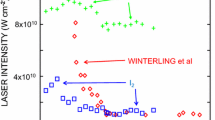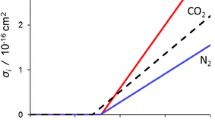Abstract
An investigation of the unexpectedly strong dependence of the threshold intensity on the gas pressure in the experimental study on the breakdown of He by short laser wavelength (Turcu et al., in Opt Commun, 134:66–68, 1997) is presented. A modified electron cascade model is applied (Evans and Gamal, in J Phys D Appl Phys, 13:1447–1458, 1980). Computations revealed reasonable agreement between the calculated thresholds and the measured ones. Moreover, the calculated electron energy distribution function and its parameters proved that multiphoton ionization of ground and excited atoms is the main source for the seed electrons, which contributes to the breakdown of helium. The effect of diffusion losses over pressures <1,000 Torr elucidated the origin of the strong dependence of the threshold intensity on the gas pressure. Collisional ionization dominates only at high pressures. No evidence for recombination losses is observed for pressures up to 3,000 Torr.








Similar content being viewed by others
References
I.C.E. Turcu, M.C. Gower, P.H. Huntington, Measurement of KrF laser breakdown threshold in gases. Opt. Commun. 134, 66–68 (1997)
C. Evans, Y.E.E.-D. Gamal, Laser induced breakdown of helium. J. Phys. D Appl. Phys. 13, 1447–1458 (1980)
H.T. Buscher, R.G. Tomlinson, E.K. Damon, Frequency dependence of optically induced gas breakdown. Phys. Rev. Lett. 15, 847–849 (1965)
N. Kroll, K.M. Watson, Theoretical study of ionization of air by intense laser pulses. Phys. Rev. A 5(4), 1883–1905 (1972)
C.H. Chan, C.D. Moody, Solution of the classical Boltzmann equation for He and Ne gas breakdown. J. Appl. Phys. 45(3), 1105–1111 (1974)
L. Friedland, Quantum aspects of laser-induced breakdown in argon. Phys. Rev. A12, 2024 (1975)
Y.E.E.-D. Gamal, I.M. Azzouz, Influence of the collision frequency on the electron distribution function in laser-induced discharges in argon. J. Phys. D Appl. Phys. 20, 187–192 (1987)
I.G. Weyl, D.I. Rosen, Laser-induced breakdown in argon at 0.35 μm: theory and experiments. Phys. Rev. A 31, 2300–2313 (1985)
D.I. Rosen, I.G. Weyl, Laser-induced breakdown in nitrogen and the rare gases at 0.53 and 0.35 μm. J. Phys. D Appl. Phys. 20, 1264–1276 (1987)
Y.E.E.-D. Gamal, M.S. Shafik, M.M. Khalil, An investigation of the wavelength-dependence of the threshold intensity of laser induced breakdown of molecular hydrogen. J. Phys. D Appl. Phys. 26, 1933–1940 (1993)
Y.E.E.-D. Gamal, M.M. Omara, Study of the electron kinetic processes in laser-induced breakdown of electronegative gases over an extended wavelength range. Radiat. Phys. Chem. 62(5–6), 361–370 (2001)
C.H. Chan, C.D. Moody, W.B. Mcknight, Significant loss mechanisms in gas breakdown at 10.6 um. J. Appl. Phys. 44(3), 1179–1189 (1973)
P.J. Davis, L.A. Smith, C. Giranda, M. Squicciarini, Laser induced plasma formation in Xe, Ar, N2, and O2 at the first four Nd- YAG harmonics. Appl. Opt. 30(30), 4358–4364 (1991)
A. Sircar, R.K. Dwivedi, R.K. Thareja, Laser induced breakdown of Ar, N2 and O2 gases using 1.064, 0.532, 0.355 and 0.266 mm radiation. Appl. Phys. B 63, 623–627 (1996)
Y.B. Zel’dovich, Y.P. Raizer, Cascade ionization of a gas by light pulse. Sov Phys JETP 20, 772–780 (1965)
A.J. Alcock, K. Kato, M.C. Richardson, New features of laser-induced gas breakdown in the ultraviolet. Opt. Commun. 6(4), 342–344 (1972)
G.J. Pert, Inverse bremsstrahlung absorption in large radiation fields during binary collisions-classical theory. J. Phys. A: Gen. Phys. 5, 506 (1972)
M. Hayashi, Recommended values of transport cross sections for elastic collision and total collision cross section for electrons in atomic and molecular gases, Report of At. Data, IPP/Univ. of Nogoya, 1981
C. Grey Morgan, Some aspects of laser-produced plasmas. Plasma Phys. Controll. Fusion 26(128), 1367–1382 (1984)
C. Grey, Morgan. Laser-induced breakdown of gases, reports on progress in physics 38, 621–665 (1975)
E.E. Ferguson, F.C. Feshenfeld, A.L. Schmeltekopf, Dissociative recombination in helium after glows. Phys. Rev. 138, A381–A385 (1965)
Author information
Authors and Affiliations
Corresponding author
Rights and permissions
About this article
Cite this article
Gamal, Y.E.ED., Abdellatif, G. Investigation of the threshold intensity versus gas pressure in the breakdown of helium by 248 nm laser radiation. Appl. Phys. B 117, 103–111 (2014). https://doi.org/10.1007/s00340-014-5807-0
Received:
Accepted:
Published:
Issue Date:
DOI: https://doi.org/10.1007/s00340-014-5807-0




